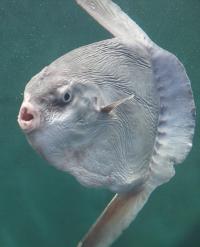 Ocean sunfish are weird. One scientist who specializes in the fish described them as “looking like a mistake.” They are the heaviest bony fish in the ocean, weighing between 545–2,205 lb.
Ocean sunfish are weird. One scientist who specializes in the fish described them as “looking like a mistake.” They are the heaviest bony fish in the ocean, weighing between 545–2,205 lb.
They look like a flattened silver disk. In English, they are called sunfish because they can often be found near the surface apparently sunbathing. Their Latin name is mola, meaning millstone for their heavy disk-like shape. They are also called moon-fish for the same reason. In German, they are called Schwimmender Kopf, or “swimming head” as some think they look like a fish head with fins.
Lacking a true tail, they swim by waving their ventral and dorsal fins. With their fins extended, they are frequently as tall as they are long. They also have no swim bladder to control buoyancy so they often float near the surface. Their dorsal fin protruding from the water can be mistaken for a shark fin.
Sunfish live in tropical to temperate waters around the globe. Around Cape Cod, in Massachusetts, from mid-August to December they are known to strand themselves on beaches. Typically there are around 60 sunfish strandings. Last year was particularly bad as the number rose to 130.
In October, a sunfish appeared in Wareham, Mass, swimming on its side, alarming local residents. Some thought the fish was sick. Some mistook it for a shark. The New York Times reports that the calls about it had become so voluminous, however, that the Wareham Department of Natural Resources was compelled to issue a plea on Facebook. The fish was swimming, it said, adding: “It is not stranded or suffering. The sunfish is FINE.”
It added, “PLEASE STOP CALLING THE POLICE DEPARTMENT ABOUT THIS SUNFISH!!”
The sunfish is often said to be harmless to humans. The same cannot be said of humans on sailboats. The problem is that fish weighing upwards of a ton floating near the surface can do considerable damage to a sailboat underway.
In the Sydney-Hobart Race, high sped collisions with sunfish have become disturbingly common, usually resulting in rudder or keel damage. Collisions have been reported between sunfish and racing yachts in the race in 2003, 2004, 2005, 2014, and 2018. In 2005, the maxi Wild Oats collided three times during the race with sunfish, suffering rudder damage. In 2018, the Far 55 Hollywood Boulevard sank after hitting a sunfish.

WTF!?. I have been sailing the Caribbean these past four years and all I really worried about was half sunken cargo containers. Until now. Not telling the wife
I saw one in Cape Cod canal! No mistaking it fir sure. A big flat disk in the water with fins!! An unusual large creature !!
Easily differentiated from a shark, the long floppy dorsal flops back and forth like a broken windshield wiper.
Although they appear to be slow and lazy they can actually swim very fast, are surprisingly agile and can breach leaping into the air several feet.
I observed this several times when swordfishing on harpoon boats here in New England.
I came across a small sunfish (about 400 lb) that swam into Sakonnet Harbor RI.
I was following it around the basin in my 20 foot center console. I poked at it a few times with a boat pole when all of a sudden it breached, coming out of the water about 6 feet and then swam away very quickly.
Without a doubt one of the strangest designs nature has come up with.
Moral of the story: Sail in a slow yacht with an encapsulated keel. My Nicholson 32 is ideal.
@Capt.JVC
Chasing after wildlife and poking it repeatedly with a pointy thing just for the heck of it is a bad thing to do and could see you in a lot of trouble depending on where you are.
Jean,
Even encapsulated keels have their own problems!
If your boat has an encapsulated iron keel, don’t get lulled into believing that you are completely free of keel worries. Although you are generally better off than sailors with exposed iron keels, you still have to carry out routine maintenance and inspection, and be aware of the warning signs of water intrusion, which could lead to bigger problems.
https://www.practical-sailor.com/blog/caring-for-encapsulated-ballast-keels-2
@Phil The keel is lead weighted, my previous boat had an iron keel bolted on and it was a constant maintenance problem. It was one of the reasons I chose a boat built at the transition period to grp where they hadn’t started messing with weight reduction by using less material.